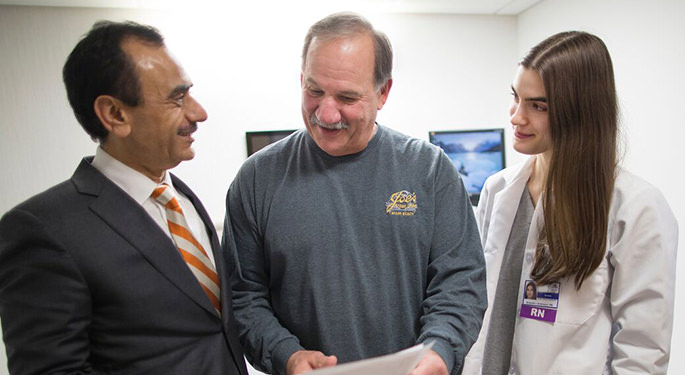Robotic Prostate Surgery

Robotic assisted laparoscopic prostatectomy is a minimally invasive surgery to remove the prostate. This operation has two types—the radical version is for prostate cancer, and the simple version is for benign prostatic hypertrophy, a condition in which the prostate gland is enlarged but not cancerous. Mount Sinai doctors performed the first robotic radical prostatectomy in New York. This operation uses a state-of-the-art robotics surgical system to remove the prostate through a few small incisions instead of one large incision, as was traditionally done in the open surgical approach.
Benefits
Robotic prostate surgery is extremely precise, which offers a variety of benefits over traditional (open) prostate surgery, including:
- Smaller incisions
- Shorter hospital stay
- Less pain
- Less risk of infection
- Less blood loss and transfusions
- Less scarring
- Faster recovery
- Superior cancer control
- Superior nerve sparing
In addition, with robotic prostate surgery, a temporary catheter remains in place for considerably less time (five to seven days instead of two weeks), and there is less risk of urinary incontinence and impotence following the robotic prostate surgery procedure.
This approach results in complete removal of cancer for nearly 95 percent of all patients whose cancer is confined to the prostate. In published long-term follow-up studies performed by Mount Sinai Urology Chair Ashutosh (Ash) K. Tewari, MD, this also means that these patients have an extremely good chance (95 percent) of reaching the 10-year survival mark.
Robotic prostate cancer surgery is extremely safe in experienced hands, but some complications are possible in any abdominal procedure. Possible complications may include bleeding, infection, blood clotting, heart attack, hernias, permanent urinary incontinence, impotence, and strictures. While intraoperative mortality is almost unheard off, it is possible with any anesthesia and surgery. Equipment malfunction is rare, happening in less than 0.4 percent of cases; Mount Sinai has three backup robots to address this remote possibility.
Surgical Outcomes
We usually evaluate the outcome of primary prostate cancer treatment by looking at cancer control, preservation of urinary continence, and preservation of sexual function. The Advanced Robotic Technique, developed by Dr. Tewari, is highly successful on all three measures, producing minimal disruption to your daily life.
- Cancer control is the ability of the surgeon to remove all cancerous tissue from the body. We measure this by looking at the surgical margins (the rim or border of the tissue removed in surgery). Once we complete the procedure, we send the prostate to the Pathology Department to test for margins and cancer grade (of any remaining malignancy).If the margins are “clean” or cancer-free, we assume that we have removed all of the malignant tissue and we have achieved cancer control.
- Urinary incontinence is determined by whether the bladder and surrounding anatomy are unaffected by removal of the prostate.
- Sexual potency is about sexual functioning, a chief concern of men undergoing prostate cancer treatment.
